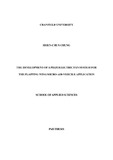JavaScript is disabled for your browser. Some features of this site may not work without it.
| dc.contributor.advisor | Zhaorong, Huang | |
| dc.contributor.author | Chung, Hsien-Chun | |
| dc.date.accessioned | 2009-07-24T11:48:37Z | |
| dc.date.available | 2009-07-24T11:48:37Z | |
| dc.date.issued | 2008-10 | |
| dc.identifier.uri | http://hdl.handle.net/1826/3480 | |
| dc.description.abstract | A micro air vehicle (MAV) is a semiautonomous airborne vehicle which measures less than 15 cm in any dimension. It can be used to access situations too dangerous for direct human intervention, e.g., explosive devices planted in buildings and video reconnaissance and surveillance, etc. As demonstrated by flying birds and insects, flapping flight is advantageous for its superior manoeuvrability and much more aerodynamically efficient at small size than the conventional steady-state aerodynamics. Piezoelectric actuators are easy to control, have high power density and can produce high output force but usually the displacement is small. With appropriate stroke amplification mechanisms piezoelectric actuators can be used to drive the flapping wings of MAV. This research aims to develop a piezoelectric fan system with 2 degrees of freedom of motion for flapping wing MAV applications. In this project, piezoelectric fans consisting of a piezoelectric layer and an elastic metal layer were prepared by epoxy bonding. A flexible wing formed by carbon fibre reinforced plastic wing spars and polymer skin was attached to two separate piezoelectric fans to make them coupled. Two sinusoidal voltages signals of different phase were then used to drive the coupled piezoelectric fans. High speed camera photography was used to characterize the two degrees of freedom motion of the wing. Theoretical equations were derived to analyse the performance of the piezoelectric fans in both quasi-static and dynamic operations, and the calculated results agreed well with the finite element analysis (FEA) modelling results. It has been observed that the phase delay between the driving voltages applied to the coupled piezoelectric fans plays an important role in the control of the flapping v and twisting motions of the wing. Selected factors such as the gap between the two piezoelectric fans which can affect the performances of the wing have been investigated and the experimental results were compared with the FEA modelling results. | en_UK |
| dc.language.iso | en | en_UK |
| dc.publisher | Cranfield University | en_UK |
| dc.rights | © Cranfield University 2007. All rights reserved. No part of this publication may be reproduced without the written permission of the copyright owner. | en_UK |
| dc.title | The Development of a PiezoelectricI Fan System for the Flapping Wing Micro-Air-Vehicle Application | en_UK |
| dc.type | Thesis or dissertation | en_UK |
| dc.type.qualificationlevel | Doctoral | en_UK |
| dc.type.qualificationname | PhD | en_UK |
